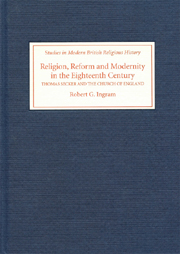Book contents
- Frontmatter
- Contents
- Dedication
- Preface
- Abbreviations
- 1 ‘Efforts at Amendment’
- 2 Becoming an Anglican
- 3 Becoming an Insider
- 4 The Church and the Enlightenment
- 5 The Church and the Parishioners
- 6 The Church and the State
- 7 The Church and America
- 8 The Church and Churches Abroad
- Epilogue
- Bibliography
- Index
- Previously published volumes in this series
7 - The Church and America
Published online by Cambridge University Press: 12 September 2012
- Frontmatter
- Contents
- Dedication
- Preface
- Abbreviations
- 1 ‘Efforts at Amendment’
- 2 Becoming an Anglican
- 3 Becoming an Insider
- 4 The Church and the Enlightenment
- 5 The Church and the Parishioners
- 6 The Church and the State
- 7 The Church and America
- 8 The Church and Churches Abroad
- Epilogue
- Bibliography
- Index
- Previously published volumes in this series
Summary
On 20 February 1741, Thomas Secker stepped into the pulpit of St Mary-le-Bow to deliver the ‘annual anniversary sermon’ to the Society for the Propagation of the Gospel in Foreign Parts (SPG). He had been invited by the archbishop of Canterbury to speak on the occasion, and the audience drew from the great and good of the English governing class. It was Secker's first public airing of his views on the religious situation in America, and, in retrospect, established an interpretative framework that remained consistent for him right through to his death. Things on the other side of the Atlantic were dire, Secker argued. The first European inhabitants ‘carried but little Sense of Christianity abroad with them’ so that among their descendants there was soon ‘scarce any Footsteps of it left, beyond the mere Name’. Americans' religious ignorance and popery's threat spurred the SPG to support missionaries and schoolteachers. ‘But at present much remains to be done,’ Secker warned.
The Society's first order of business was to Christianize, Protestantize, and Anglicanize the ‘heathens’ who lived in America. ‘Our blessed Lord hath intrusted his Followers, to preserve his Gospel in Purity, where it is; and communicate it, where it is not,’ Secker averred. Slaves – who brought with them from Africa ‘the grossest Idolatry, and the most savage Dispositions’ – suffered under conditions in America that were ‘nearly as hard as possible’. ‘And thus,’ he lamented, ‘many thousands of them spend their whole Days, one Generation after another, undergoing with reluctant Minds continual Toil in this World, and comforted with no Hopes of Reward in a better.’
- Type
- Chapter
- Information
- Religion, Reform and Modernity in the Eighteenth CenturyThomas Secker and the Church of England, pp. 209 - 259Publisher: Boydell & BrewerPrint publication year: 2007



